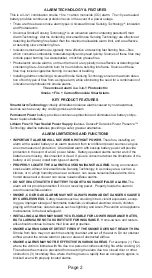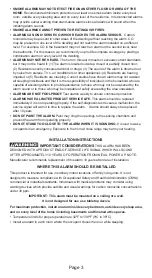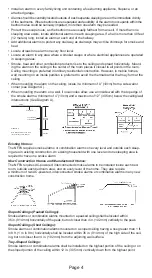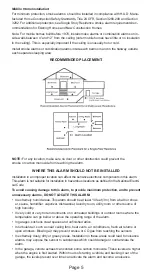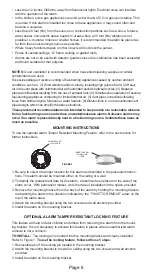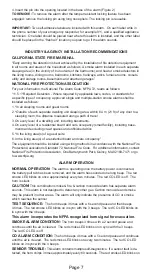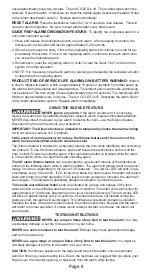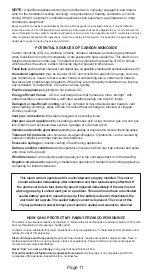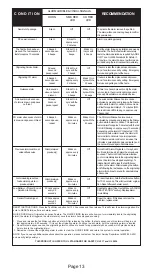
Page 10
WHAT YOU SHOULD KNOW ABOUT CO
Carbon monoxide (CO) is an insidious poison. It is a colorless, odorless, tasteless gas. It is
a cumulative poison . Even low levels of CO have been shown to cause brain and other vital
organ damage in unborn infants with no effect on the mother .
The following symptoms are related to CARBON MONOXIDE POISONING and should be
discussed with ALL members of the household:
MILD EXPOSURE:
Slight headache, nausea, vomiting, fatigue (often described as “flu-like” symptoms).
MEDIUM EXPOSURE:
Severe throbbing headache, drowsiness, confusion, fast heart rate .
EXTREME EXPOSURE:
Unconsciousness, convulsions, cardiorespiratory failure, death .
Many cases of reported CARBON MONOXIDE POISONING indicate that victims are aware
they are not well, but they become so disoriented that they are unable to save themselves by
either exiting the building or calling for assistance . Young children and household pets may
be the first affected.
Your combination alarm is designed to detect the toxic CO fumes that result from incomplete
combustion, such as those emitted from appliances, furnaces, fireplaces and auto exhaust.
What Levels of CO Cause an Alarm?
Underwriters Laboratories Inc. UL2034 defines three specific alarm points by which all
residential CO alarms must alarm. They are measured in parts per million (ppm) of CO over
time (in minutes).
UL2034 Required Alarm Points:
• If the alarm is exposed to 400 ppm of CO, it must alarm between 4 and 15 minutes.
• If the alarm is exposed to 150 ppm of CO, it must alarm between 10 and 50 minutes
• If the alarm is exposed to 70 ppm of CO, it must alarm between 60 and 240 minutes.
• This alarm is designed to act as a continuous monitor . It is not designed for use as a short-term
testing device to perform a quick check for the presence of CO .
WHAT TO DO IF CARBON MONOXIDE IS DETECTED
Never ignore the alarm sound.
If you hear the alarm horn
sounding a continuous horn pattern of 4 beeps, 5 second pause, carbon monoxide has been
detected . Evacuate everyone from the dwelling .
Never disconnect the power from the alarm to stop a
nuisance alarm.
Doing so will disable the alarm and remove the protection . In the case of
a true unwanted alarm, use the silence feature . The silence feature is intended to temporarily
silence the alarm while the problem is identified and corrected. Open a window or fan the CO
away from the alarm . The alarm will reset automatically when it returns to normal operation .
The alarm will stop sounding automatically
Actuation of your CO Alarm indicates the presence of carbon monoxide
(CO), which can kill you.
In other words, when your CO Alarm sounds, you must not ig-
nore it! Some individuals are more sensitive to CO than others, including people with cardiac
or respiratory problems, infants, unborn babies, pregnant mothers and elderly people can be
more quickly and severely affected by CO . Members of sensitive populations should consult
their doctors for advice on taking additional precautions .
IF THE CO ALARM SOUNDS:
1 . Operate the Silence button .
2 . Call your emergency services, fire department or 911. Write down the number of your local
emergency service here: ___________________________________ .
3 . Immediately move to fresh air—outdoors or by an open door or window. Do a head count
to check that all persons are accounted for . Do not reenter the premises or move away
from the open door or window until the emergency services responder has arrived, the
premises have been aired out, and your alarm remains in its normal condition .
4. After following steps 1-3, if the alarm reactivates within a 24 hour period, repeat steps 1-3
and call a qualified appliance technician to investigate for sources of CO from fuel-burning
equipment and appliances and inspect for proper operation of this equipment . If problems are
identified during this inspection, have the appliances and equipment serviced immediately.
Note any combustion equipment not inspected by the technician and consult the manufactur-
ers’ instructions or contact the manufacturer(s) directly for more information about CO safety
and this equipment . Make sure that motor vehicles are not, and have not been, operating in
an attached garage or adjacent to the residence. Write down the number of a qualified appli-
ance technician here: _______________________________________________________ .
Summary of Contents for MPC322S
Page 14: ...Page 14...


